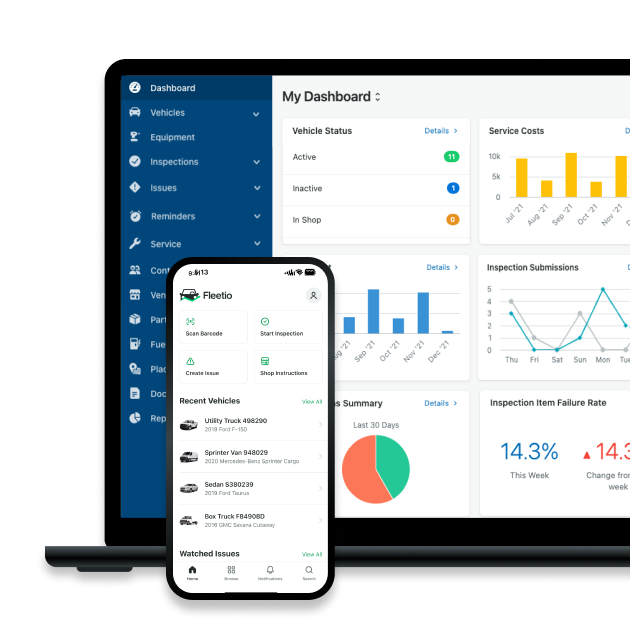Strengthen PM Practices through Clear Communication
Feb 10, 2023
4 min read
For many fleets, slipping preventive maintenance (PM) compliance is caused by a lack of transparency and communication around scheduling and what work needs to be done. Fleets can benefit from a maintenance scheduling software that provides alerts, reminders and an effective method of communication.
Common PM Management and Adherence Obstacles
Managing PM can be a lot like herding cats with your eyes closed — it’s probably possible, but it’s more likely to be painful, frustrating and ineffective. Without proper planning, scheduling and communication, it’s difficult to wrangle in mobile assets for service on a whim or scramble to get a vehicle into the bay before it breaks down.
To improve PM compliance and ensure assets are in safe, reliable condition, there needs to be a sustainable and productive service workflow in place. If you’re still using manual processes to track fleet data, then the first step to creating a more manageable workflow is organization. There needs to be a clear delineation between:
- Repair orders
- PM work orders
- Failed inspection items
- Overdue service
- Due soon service
Breaking down service into these main categories can help you get a better view of current scheduled service, which overdue assets to prioritize for service, where service expenses are going and, of course, PM compliance rates. While categorizing service can set a strong foundation to improve the service workflow, you still need a way to efficiently schedule maintenance and communicate service needs to both the shop — whether service is done in house or outsourced — and the drivers.
Automated fleet management software (FMS) streamlines service workflows, from automatically collecting and sorting service data so fleets can manage their preventive maintenance programs easier to improving communication visibility to ensure assets are getting serviced when needed.
Improve Service Workflows with Automation
Automating service workflows makes it easier for fleets to stay proactive with PM schedules, as well as quickly get assets into the shop for repairs and failed inspection items. When an asset nears its PM interval, the software sends a due soon alert so service can be scheduled in advance to minimize downtime. Drivers can use the software’s native fleet app to submit digital asset inspections in real time, and failed inspection items alert managers, kicking off the service workflow. This better allows drivers in the field to easily communicate asset health data and ensures the concerns they kick up are addressed.
While this heightened, real-time visibility into failed inspection items and upcoming PM allows for improved service scheduling and reduced downtime, it doesn’t necessarily address the issue of streamlined communication with the shop. This is where digital work orders come into play. Managers can assign work orders to specific technicians who can use the mobile app to view, comment in and clock in/out of jobs. This provides an organized way for managers to see not only what work was performed, but also whether additional work was suggested based on the technician’s findings. Consolidating task-oriented communication not only improves visibility of that communication, it also strengthens assets’ service history data so that in the event the asset has a recurring issue or break down, you can easily see if it was avoidable based on service recommendations from the technician.
Interested in tips on how to make a preventive maintenance schedule? Check out Fleet Preventive Maintenance Components & Best Practices!
Streamline fleet-wide collaboration to improve asset health with Fleetio!
Learn moreService Reminders Improve PM Compliance
Service reminders play a major role in helping you stay on top of PM management and compliance. Fleet maintenance software, like FMS, allows fleets to set up service and maintenance reminders, such as the aforementioned due soon alert, as well as overdue service alerts. Fleets can set these reminders to be sent to anyone who needs to see them, such as account admins and managers, as well as the driver to whom the asset is assigned and the technician to whom the work order is assigned. Using service reminders not only makes it easier to schedule service-related downtime, it also ensures everyone in the workflow knows when to be where, why, what’s being done and when an asset is ready for pickup.
Service reminders are also valuable when it comes to prioritizing overdue service. FMS provides a vehicle-centric dashboard view and minimizes clutter so you can better manage overdue reminders efficiently — without being overwhelmed. Once a reminder for a service task comes up in FMS, you can use it in conjunction with work orders to schedule PM.
By making service-oriented communication more visible — and improving communication methods — fleets can better track, manage and schedule service to improve uptime and PM compliance. And since FMS automatically collects and organizes your data in filterable reports, you can quickly spot high-priority service needs to reduce breakdown instances.
Find out how Fleetio can help your team improve fleet-wide communication and collaboration for improved service workflows. Start your free trial or request a personalized demo today!

Senior Fleet Content Specialist
As a Senior Fleet Content Specialist at Fleetio, Rachael Plant uses her near decade of industry experience to craft practical content aimed at helping fleet professionals tackle everyday challenges with confidence.
LinkedIn|View articles by Rachael PlantReady to get started?
Join thousands of satisfied customers using Fleetio
Questions? Call us at 1-800-975-5304
